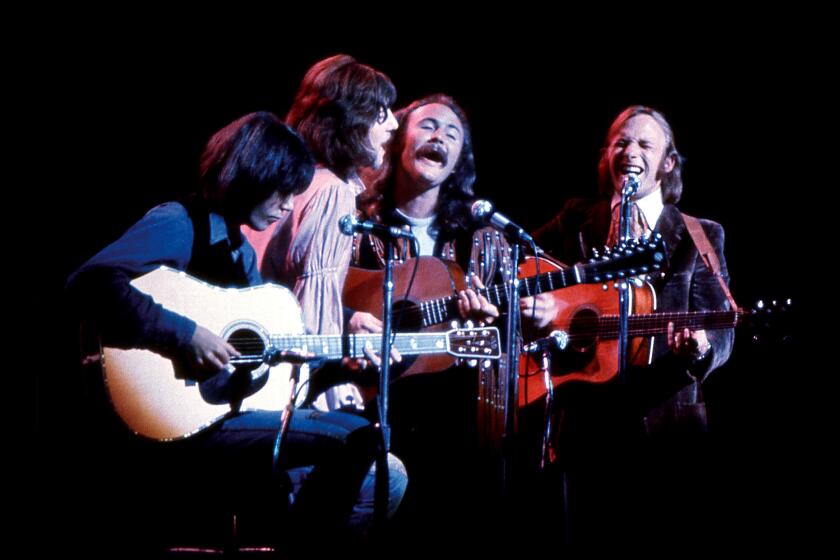Q&A: ‘Lost Landscapes of Los Angeles’: Rick Prelinger’s new film of old home movies and studio outtakes
- Share via
A camera pans the streets of downtown Los Angeles from the window of a moving car, cruising past Mickie’s Café, John’s Dog House, an Orange Julius, the Angel’s Flight Café and the Burbank Burlesque, boasting a chorus line of “California Beauties.”
If these places don’t sound familiar it’s because they’re long gone — shuttered, reborn as restaurants or discount clothing shops or torn down to make way for Bunker Hill’s towering Financial District.
But in a beguiling new film by Rick Prelinger, the Bay Area filmmaker known for working with bits of found film, they have come back to life.
“Lost Landscapes of Los Angeles” splices together home movies and studio outtakes, primarily stock driving footage that serves as background in scenes where characters ride in cars or buses. The film, whose footage dates from the 1920s to the 1960s, is more about mood than in telling a literal story — a nonlinear, highly poetic gathering of moving images that examine our city as it no longer exists.
It also doesn’t contain a soundtrack — which means the audience is free to chat or name a location they might be familiar with as the film screens. Says Prelinger: “I really like the idea of people talking and making the soundtrack and coming to an understanding together.”
The film is one in a series of movies that Prelinger has made in this way — including 10 on San Francisco and five on Detroit. He also made the 2013 film “No More Road Trips,” which tells the story of a road trip — from one side of the country to the other — by employing an array of amateur footage.
I wanted to show as much as I could of the historical downtown. One of the objectives of this is getting people to think about the future. What kind of city do you want to live in?
— Rick Prelinger, director, “Lost Landscapes of Los Angeles”
“Lost Landscapes of Los Angeles” captures L.A. as it transforms from rural Western outpost to full-on postwar urban/suburban center knitted together by traffick-y freeways. And for fans of both history and filmmaking, it is engrossing to watch.
In advance of the film’s premiere at the performance space Redcat on Monday evening, Prelinger took time to chat with me via telephone about the delights of found footage, how he finds his home movies and what he learned about Los Angeles in making this movie.
The conversation has been edited for flow.
You pored through hundreds of hours of footage to piece together the film. How do you decide what will go in?
It’s about a visual experience and sensibility. I put in a lot of sequences that haunted me for the way they were shot or what they show. One scene shows people picking up shells and moon stones in Redondo Beach. It’s hypnotic, it’s mysterious, it’s enigmatic. But it’s also really beautiful — to see all of these well-dressed people rushing away from the waves so their feet don’t get wet.
You turned up some incredible Los Angeles sights: the Sphinx Realty building on Fairfax and billboards for bomb shelters on Wilshire. Where do you find your material?
Nowadays people give me material. There are so many families that have broken up and film just isn’t important to them as an object. Sometimes I’ve gotten it on Ebay, but I don’t like the commodification of these films. Sometimes you have people who cut them up in four pieces so that they can sell them individually. It’s really friends who find me material.
How did you get into collecting home movies and other amateur types of filmmaking?
When I lived in New York I collected educational and industrial films. They’re this tendentious record of power, of getting people to conform. Everything that wasn’t white middle class wasn’t there. White was the default. But it was valuable even in its gaps. That collection went to the Library of Congress, but I still collect a lot of that.
Over time I became much more interested in home movies. They are what I think of as cinema now. Home movies are incredibly random and incredibly specific. Home movies are very codified. Typically home movies have positive motivations around them. People often shoot people or places that they loved. There are birthday parties and New Year’s celebrations — like the one you see at Angel’s Flight Café in [the Los Angeles film].
But while the sameness is fascinating, you look for the differences. There’s always an exception that makes you understand the rule. You never know what you’re going to get when you look at a reel of them.
And in this case you used studio outtakes and stock driving footage too.
A lot of studios dump nitrate material and a lot of that ended up at the Internet Archive [the online digital repository], where I’m a board member. When you watch a movie and you see that view out of a car or a bus window, it often looks grainy or jumpy or out of focus. But in actuality, these are sharp and steady and well done. And they capture a place at a very specific moment in time.
How did the advancement of technology affect the type of film you see from different eras?
In the 1920s, film was quite expensive. If you look at material from the ‘20s and ‘30s prior to 1933, the cost of stock and processing for one of hour of film was about $1,400 in contemporary dollars. So that set a dividing line.
But in 1933, Kodak introduces the 8-mm camera. It takes a few years to get traction, but suddenly it comes within the reach of working families, especially if there’s a union wage earner in the family. You start to see home movies from families of color, from rural families, from working families you might not expect to see movies from.
So how do you put this all together into a film?
Starting in September I basically scouted every piece of footage I had in my archives that was digitized and was related to Los Angeles. We scanned some material too. I got everything — from the mountains to the desert to the city. And I put it all on a hard disk and all together it was four terabytes. And I started to just look through it. Anything I thought I might want, I assembled on a timeline — like writing a book using index cards.
So I create this long timeline with a tentative sense of order, an order that is part topographical and part intuitive. I try to have an intuitive sense of what works rhythmically. I played the piano when I was a kid, so it’s like that — like making music.
My first cut was seven to eight hours. Now it’s 78 minutes. As a friend says, “Subtraction is growth.”
You include a lot of vintage footage of downtown.
I wanted to privilege downtown since it is going through so many changes. I wanted to show as much as I could of the historical downtown. One of the objectives of this is getting people to think about the future. What kind of city do you want to live in? I’m not from Los Angeles. I’m not telling people what to think. But I am providing the materials.
There is also a lot of footage shot from moving cars. Why?
I was really interested in showing Los Angeles in motion. Though I did try to modulate it and there are points where you stop and get out. This particular film is stronger on mass public space than it is on community space. There is some footage of family and community environments. But it was more about showing the macro.
What did you learn about Los Angeles in the process?
I think my first friend from Los Angeles was from Echo Park. When I started to learn about L.A. in the ‘70s, I’d always had that idea of suburbs in search of a city. But what I learned was that it was a lie because here was this area that was very concentrated and people walked and rode the bus. The film has that too. You have these people in courtyards and people on the street. There is a vivid sense of street life.
Rick Prelinger’s “Lost Landscapes of Los Angeles” screens at Redcat on Monday, Nov. 16, at 6:30 p.m. and 8:30 p.m. Prelinger will be in attendance to discuss the film. 631 W. 2nd St., downtown Los Angeles, redcat.org.
There will also be a screening of Prelinger’s 2013 film, “No More Road Trips,” courtesy of the Los Angeles Film Forum at the Downtown Independent on Sunday evening at 7:30 p.m. 251 S. Main St., downtown Los Angeles, lafilmforum.org.
Find me on Twitter @cmonstah.
More to Read
The biggest entertainment stories
Get our big stories about Hollywood, film, television, music, arts, culture and more right in your inbox as soon as they publish.
You may occasionally receive promotional content from the Los Angeles Times.










